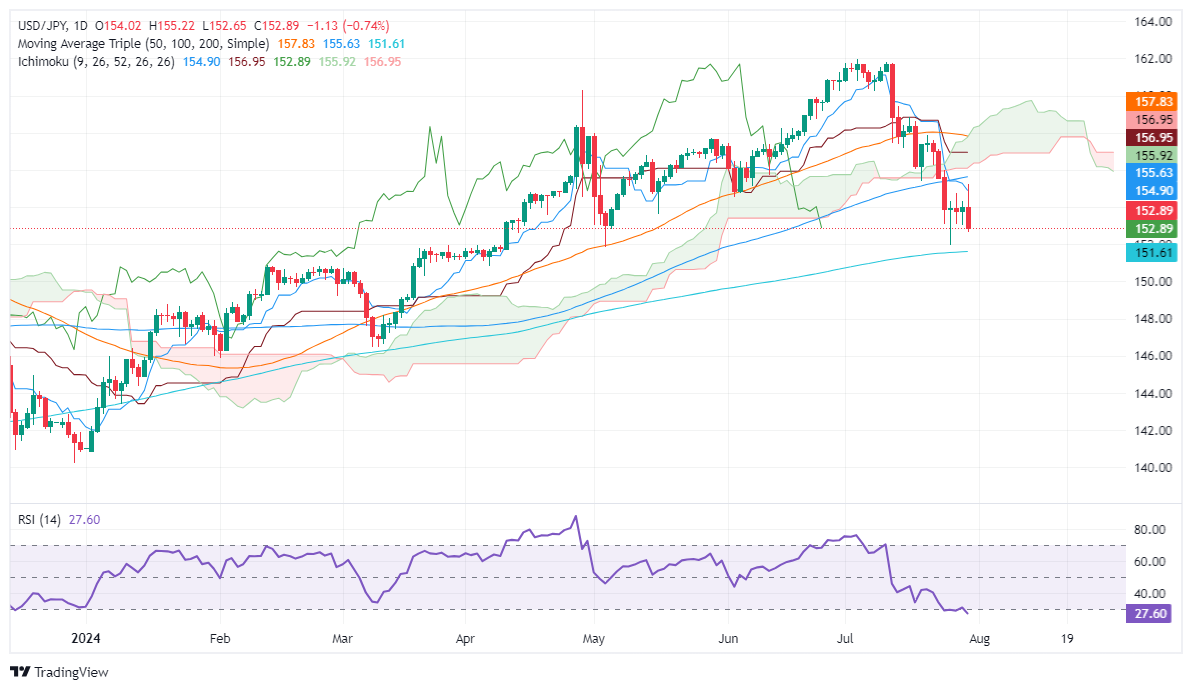USD/JPY tumbles as BoJ rate hike rumors, overshadows strong US data
- USD/JPY ends Tuesday down, trading at 152.84, amid BoJ rate hike rumors.
- Strong US JOLTS data and higher-than-expected Consumer Confidence failed to boost USD/JPY.
- BoJ reportedly considering a rate hike to 0.25% and reducing JGB purchases, adding market uncertainty.
The USD/JPY finished Tuesday’s session with losses amid rumors that the Bank of Japan (BoJ) will hike rates on Wednesday’s monetary policy decision. This headline overshadowed a strong US jobs report in the United States (US), reinforcing a tight labor market. As Wednesday’s Asian session begins, the major trades at 152.84, virtually unchanged.
BoJ rate hike speculation eclipses robust US economic indicators.
Wall Street ended Tuesday’s session mixed after US JOLTS data was better than expected. June figures came at 8.184 million, less than the upwardly revised May number of 8.23 million but exceeding forecasts of 8 million. Further data showed that July’s Consumer Confidence revealed by the Conference Board (CB) exceeded estimates of 99.7, coming to 100.3 above the downwardly revised June figures of 97.8.
Although the data was positive and kept the USD/JPY at around 155.00, Japanese press reports revealed that BoJ is considering raising its overnight interest rates to around 0.25%, according to Nikkei.
The article also mentioned that the BoJ would likely decide by how much and at what pace it will reduce monthly purchases of Japanese Government Bonds (JGBs). Market participants estimate the BoJ will cut bond-buying in half to around $19.5 billion US Dollars by the end of fiscal 2025.
The BoJ will also reveal the outlook report, which will update Real GDP and Core CPI forecasts. Even though the BoJ’s decision was leaked, a Reuters poll showed that 24% of economists expect a 15-bps hike, while 76% expect no change. Nevertheless, money markets show odds of 38% for an increase in rates.
USD/JPY Price Analysis: Technical outlook
From a technical perspective, the USD/JPY is set to extend its losses, yet traders will need to decisively clear the October 21, 2022, high of 151.94, which could pave the way for further downside. Once surpassed, the 151.00 figure would be up for grabs, ahead of the latest cycle low of 146.48, the March 11 low. On the flip side, if USD/JPY climbs past 153.00, it could rally and challenge 154.00.

Japanese Yen PRICE Today
The table below shows the percentage change of Japanese Yen (JPY) against listed major currencies today. Japanese Yen was the strongest against the Canadian Dollar.
| USD | EUR | GBP | JPY | CAD | AUD | NZD | CHF | |
|---|---|---|---|---|---|---|---|---|
| USD | 0.00% | -0.01% | 0.09% | 0.00% | -0.02% | -0.00% | 0.01% | |
| EUR | -0.00% | 0.00% | 0.10% | -0.01% | -0.03% | 0.00% | 0.01% | |
| GBP | 0.01% | -0.00% | 0.08% | -0.01% | -0.04% | 0.00% | 0.01% | |
| JPY | -0.09% | -0.10% | -0.08% | -0.04% | -0.12% | -0.11% | -0.05% | |
| CAD | -0.00% | 0.01% | 0.01% | 0.04% | -0.04% | -0.00% | 0.00% | |
| AUD | 0.02% | 0.03% | 0.04% | 0.12% | 0.04% | 0.03% | 0.03% | |
| NZD | 0.00% | -0.01% | -0.01% | 0.11% | 0.00% | -0.03% | 0.00% | |
| CHF | -0.01% | -0.01% | -0.01% | 0.05% | -0.00% | -0.03% | -0.01% |
The heat map shows percentage changes of major currencies against each other. The base currency is picked from the left column, while the quote currency is picked from the top row. For example, if you pick the Japanese Yen from the left column and move along the horizontal line to the US Dollar, the percentage change displayed in the box will represent JPY (base)/USD (quote).

